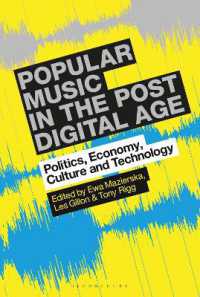Full Description
The market-leading textbook that offers clear, robust and pragmatic guidance on your dissertation or research project. Ranked as the most highly cited text in Business, Marketing, Accounting & Economics! According to the Financial Times' Teaching Power Rankings (research by Open Syllabus)
With over 500,000 copies sold, Research Methods for Business Students by Saunders, Lewis, and Thornhill is the definitive textbook for Business, Marketing, and Management students conducting a research-led project or dissertation.
This fully revised 9th edition provides excellent coverage guiding you through the entire process, from deciding on a research topic to writing your dissertation or project and presenting your academic poster. By taking a transactional approach, the textbook will help you choose your project through critically reviewing the literature and designing your research, answering key questions such as:
How do I generate a research idea and design my research?
How do I review the literature critically?
Why is research philosophy relevant to my research?
How do I collect and analyse my data?
When and what do I need to write?
How can I do research virtually?
This comprehensive guide to conducting research will support you step-by-step at every stage of the process, offering a wealth of thought-provoking features and activities, such as tips and tricks from other students' experiences on their research projects and a complete glossary of terms. It provides case studies, news, and articles based on the latest virtual and face-to-face methods, discussing how research is used in practice within organisations worldwide. Self-study prompts will further encourage you to apply what you have learned to your own research project.
Get data-confident with the worked examples, self-test questions, and downloadable datasets, and take the Heightening Awareness of Research Philosophy survey (HARP) to understand more about your own research philosophy and how it affects your research project.
Written by experts in the field, this resource guides you through developing your research skills by taking a clear, concise, and transparent approach, helping you complete and successfully present your research.
This edition is also available in Revel®.
Revel® is Pearson's newest way of delivering respected content. Fully digital and highly engaging, Revel replaces the textbook and gives you everything you need for the course, and more.
Informed by extensive research on how people read, think, and learn, Revel® is an interactive learning environment that enables you to read, practice, and study in one continuous experience — for less than the cost of a traditional textbook.
Contents
Brief Contents
Research, reflective diaries and the purpose of this book
Generating a research idea and developing your research proposal
Critically reviewing the literature
Understanding research philosophy and approaches to theory development
Formulating the research design
Negotiating access and research ethics
Selecting samples
Obtaining and evaluating secondary data
Collecting primary data using observation
Collecting primary data using interviews and diaries
Collecting primary data using questionnaires
Analysing data quantitatively
Analysing data qualitatively
Writing and presenting the project report
Appendix 1: Systems of referencing
Appendix 2: Calculating the minimum sample size
Appendix 3: Guidelines for non-discriminatory language








